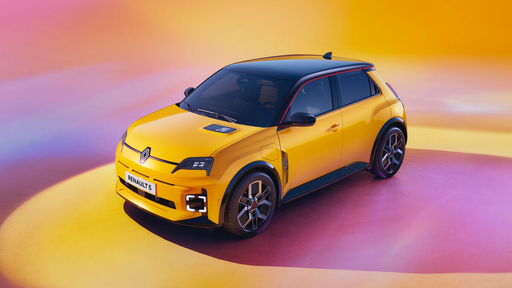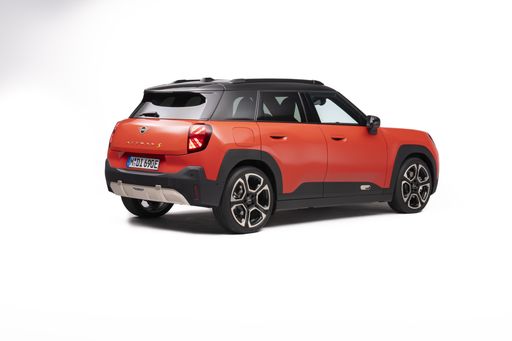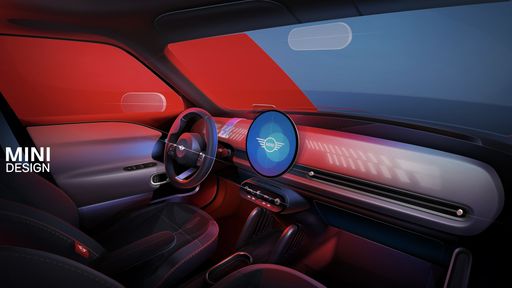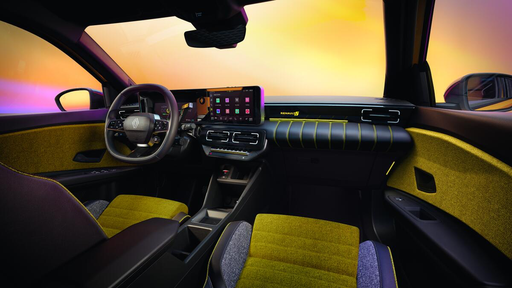In the evolving landscape of electric vehicles, two contenders stand out with their stylish designs and impressive specifications—the MINI Aceman and the Renault R5. Both embody the spirit of modernity while prioritizing sustainability. However, as they compete for the attention of eco-conscious consumers, their technical specifications and innovations leave enthusiasts eager for a deeper comparison.
MINI Aceman vs Renault R5 – Performance, range & efficiency compared
Everyday use, family trips or long-distance drives – here’s where the differences show.
Discover whether MINI Aceman or Renault R5 fits your lifestyle better.
Body Types and Design Philosophy
The MINI Aceman adopts a sporty SUV design, boasting a robust presence complemented by its modern aesthetics. It measures 4079 mm in length, 1754 mm in width, and stands at a height of 1514 mm, creating a versatile and bold profile suited for both city driving and adventurous outings.
In contrast, the Renault R5 embodies the hatchback design, harking back to its iconic predecessors while embracing contemporary styling cues. Smaller yet agile, the R5 measures 3922 mm in length, 1744 mm in width, and reaches a height of 1498 mm, making it an ideal city car that’s easy to maneuver in tight spaces.
Power and Performance
Under the hood, the MINI Aceman offers an electrifying choice of power outputs, ranging from 184 HP to a commanding 258 HP, providing drivers with thrilling acceleration. It achieves a 0-100 km/h time ranging from 6.4 to 7.9 seconds, depending on the variant, making it remarkably sprightly for an SUV.
The Renault R5, while slightly less powerful, delivers respectable performance with power outputs from 95 HP to 150 HP. The acceleration ranges from 8 to 9 seconds for the R5, ensuring an exhilarating drive, particularly within urban settings.
Electric Range and Efficiency
Range anxiety is a common concern among electric vehicle owners, but both models excel in efficiency. The MINI Aceman boasts an impressive electric range of up to 405 km, thanks to its dual battery options of 38.5 kWh and 49.2 kWh. With a consumption rate as low as 14.0 kWh/100km, the Aceman is designed for the modern commuter.
The Renault R5 holds its ground with a range of up to 405 km using a 40 kWh battery. However, its consumption rate is slightly higher at 14.8 kWh/100km. While both vehicles prioritize efficiency, the Aceman's enhanced range could be a deciding factor for consumers looking for longer excursions without frequent recharging.
Interior Space and Practicality
Despite being an SUV, the MINI Aceman offers a manageable trunk capacity of 300 liters, suitable for day-to-day shopping or weekend getaways. With seating for five, it ensures ample room for passengers without compromising comfort.
The Renault R5, while having a slightly larger trunk capacity of 326 liters, is designed primarily for urban mobility, making it practical for city dwellers who value space efficiency. Both vehicles can comfortably accommodate five individuals, showcasing versatility in their design philosophies.
Technological Innovations
Modern drivers expect cutting-edge technology, and both the MINI Aceman and Renault R5 come equipped with innovative features. The Aceman offers an intuitive infotainment system with a focus on user experience, seamlessly integrating connectivity options and advanced driver-assistance systems.
The Renault R5 incorporates similar tech advancements, boasting modern connectivity features that appeal to tech-savvy users. It focuses on creating a user-friendly environment that enhances the driving experience, solidifying its status as a forward-thinking hatchback.
Conclusion: A Choice of Style and Purpose
In the battle between the MINI Aceman and the Renault R5, both vehicles showcase their unique strengths and cater to different segments of the electric vehicle market. The Aceman stands out with its robust SUV design, higher performance metrics, and superior electric range. Conversely, the R5 provides an iconic hatchback experience, making it ideal for urban environments and those looking for a compact, efficient ride.
Ultimately, the choice between the two will come down to personal preferences in style, performance, and intended use. As the automotive world shifts towards electric mobility, both models represent significant steps forward in eco-friendly transportation.
Here’s where it gets real: The technical differences in detail
Costs and Efficiency:
Price and efficiency are key factors when choosing a car – and this is often where the real differences emerge.
Renault R5 has a minimal advantage in terms of price – it starts at 23900 £, while the MINI Aceman costs 25500 £. That’s a price difference of around 1543 £.
In terms of energy consumption, the advantage goes to the MINI Aceman: with 14 kWh per 100 km, it’s hardly perceptible more efficient than the Renault R5 with 14.80 kWh. That’s a difference of about 0.80 kWh.
Range is almost identical – both manage about 405 km on a single charge.
Engine and Performance:
Power, torque and acceleration are the classic benchmarks for car enthusiasts – and here, some clear differences start to show.
When it comes to engine power, the Renault R5 has a decisively edge – offering 540 HP compared to 258 HP. That’s roughly 282 HP more horsepower.
In acceleration from 0 to 100 km/h, the Renault R5 is significantly quicker – completing the sprint in 3.50 s, while the MINI Aceman takes 6.40 s. That’s about 2.90 s faster.
In terms of top speed, the Renault R5 performs noticeable better – reaching 270 km/h, while the MINI Aceman tops out at 200 km/h. The difference is around 70 km/h.
There’s also a difference in torque: Renault R5 pulls convincingly stronger with 4800 Nm compared to 350 Nm. That’s about 4450 Nm difference.
Space and Everyday Use:
Cabin size, boot volume and payload all play a role in everyday practicality. Here, comfort and flexibility make the difference.
Both vehicles offer seating for 5 people.
In curb weight, Renault R5 is somewhat lighter – 1447 kg compared to 1720 kg. The difference is around 273 kg.
In terms of boot space, the Renault R5 offers minimal more room – 326 L compared to 300 L. That’s a difference of about 26 L.
In maximum load capacity, the Renault R5 performs minimal better – up to 1106 L, which is about 101 L more than the MINI Aceman.
When it comes to payload, MINI Aceman evident takes the win – 530 kg compared to 418 kg. That’s a difference of about 112 kg.
Who wins the race?
The Renault R5 proves to be leaves the rival little chance and therefore becomes our DriveDuel Champion!
Renault R5 is the better all-rounder in this comparison.
 @ Renault Group Media
@ Renault Group Media
Renault R5
MINI Aceman
The MINI Aceman offers a fresh take on urban mobility, blending iconic design elements with modern technology. Its compact form is paired with an interior that exudes both comfort and style, making it a popular choice for city drivers. With an emphasis on sustainability, the Aceman features eco-friendly materials and innovative features that enhance the driving experience.
details @ MINI / BMW Group Press
@ MINI / BMW Group Press
 @ MINI / BMW Group Press
@ MINI / BMW Group Press
 @ MINI / BMW Group Press
@ MINI / BMW Group Press
Renault R5
The Renault R5 is a classic hatchback that captured the imagination of drivers with its distinctive design and compact versatility. Its agile handling and efficient performance made it a popular choice in urban settings and winding country roads alike. With a blend of style and practicality, the Renault R5 remains a beloved icon in automotive history.
details @ Renault Group Media
@ Renault Group Media
 @ Renault Group Media
@ Renault Group Media
 @ Renault Group Media
@ Renault Group Media
 @ MINI / BMW Group Press
@ MINI / BMW Group Press
|
 @ Renault Group Media
@ Renault Group Media
|
|
|
|
Costs and Consumption |
|
|---|---|
|
Price
25500 - 36200 £
|
Price
23900 - 137100 £
|
|
Consumption L/100km
-
|
Consumption L/100km
-
|
|
Consumption kWh/100km
14 - 16 kWh
|
Consumption kWh/100km
14.8 - 15.2 kWh
|
|
Electric Range
303 - 405 km
|
Electric Range
307 - 405 km
|
|
Battery Capacity
38.5 - 49.2 kWh
|
Battery Capacity
40 - 52 kWh
|
|
co2
0 g/km
|
co2
0 g/km
|
|
Fuel tank capacity
-
|
Fuel tank capacity
-
|
Dimensions and Body |
|
|---|---|
|
Body Type
SUV
|
Body Type
Hatchback
|
|
Seats
5
|
Seats
2 - 5
|
|
Doors
5
|
Doors
3 - 5
|
|
Curb weight
1720 - 1825 kg
|
Curb weight
1447 - 1524 kg
|
|
Trunk capacity
300 L
|
Trunk capacity
326 L
|
|
Length
4079 mm
|
Length
3922 - 4080 mm
|
|
Width
1754 mm
|
Width
1744 - 2030 mm
|
|
Height
1514 mm
|
Height
1380 - 1498 mm
|
|
Max trunk capacity
1005 L
|
Max trunk capacity
1106 L
|
|
Payload
450 - 530 kg
|
Payload
396 - 418 kg
|
Engine and Performance |
|
|---|---|
|
Engine Type
Electric
|
Engine Type
Electric
|
|
Transmission
Automatic
|
Transmission
Automatic
|
|
Transmission Detail
Reduction Gearbox
|
Transmission Detail
Reduction Gearbox
|
|
Drive Type
Front-Wheel Drive
|
Drive Type
Front-Wheel Drive, Rear-Wheel Drive
|
|
Power HP
184 - 258 HP
|
Power HP
122 - 540 HP
|
|
Acceleration 0-100km/h
6.4 - 7.9 s
|
Acceleration 0-100km/h
3.5 - 9 s
|
|
Max Speed
160 - 200 km/h
|
Max Speed
150 - 270 km/h
|
|
Torque
290 - 350 Nm
|
Torque
225 - 4800 Nm
|
|
Number of Cylinders
-
|
Number of Cylinders
-
|
|
Power kW
135 - 190 kW
|
Power kW
90 - 397 kW
|
|
Engine capacity
-
|
Engine capacity
-
|
General |
|
|---|---|
|
Model Year
2024 - 2025
|
Model Year
2025 - 2027
|
|
CO2 Efficiency Class
A
|
CO2 Efficiency Class
A
|
|
Brand
MINI
|
Brand
Renault
|
Is the MINI Aceman offered with different drivetrains?
The MINI Aceman is available as Front-Wheel Drive.
The prices and data displayed are estimates based on German list prices and may vary by country. This information is not legally binding.
